Ski: 2021-2022 Line Sir Francis Bacon, 184 cm
Available Lengths: 176, 184, 190 cm
Blister’s Measured Tip-to-Tail Length: 182.6 cm
Stated Weight per Ski: 1850 grams
Blister’s Measured Weight per Ski: 1875 & 1881 grams
Stated Dimensions: 143-107-139 mm
Blister’s Measured Dimensions: 141.8-106.4-138.4 mm
Stated Sidecut Radius (184 cm): 16 meters
Measured Tip & Tail Splay (ski decambered): 58.6 mm / 60.8 mm
Measured Traditional Camber Underfoot: ~3 mm
Core: Paulownia/Maple + Fiberglass Laminate
Base: “Fatty” 1.7 mm Sintered
Factory Recommended Mount Point: -1.9 cm from center; 89.4 cm from tail
Boots / Bindings: Nordica Strider 120; Salomon S/Pro 130 / Marker Jester
Test Location: Crested Butte, CO
Days Skied: 15
[Note: Our review was conducted on the 19/20 Sir Francis Bacon, which was not changed for 20/21 or 21/22, apart from graphics.]

Intro
The Sir Francis Bacon has been a staple in Line’s collection for over a decade, filling the role of a wider all-mountain freestyle ski. It started off in 2006 as a 115mm-wide twin-tip ski that was designed to let skiers like Eric Pollard (who helped design it), take their tricks into the backcountry.
Then the Bacon got overhauled for the 11/12 season, getting slimmed down to 108 mm underfoot. It got redesigned again for the 15/16 season, slimming down even more to 104 mm underfoot, and it also featured a much lighter construction.
Up until this season, the “SFB” hadn’t been changed since 15/16 (apart from graphics), but Line is once again redesigning this iconic ski for 19/20. The new ski is getting a bit fatter, counterintuitively losing some weight, and now features convex tips and tails.
In other words, this new Bacon sounds very different than the current iteration. So how true is that in reality?
What Line says about the 19/20 Sir Francis Bacon
“All-new and primed to change your conception of what’s possible on snow, the Sir Francis Bacon opens up new lanes of creative skiing. Bumped up to 107mm underfoot, and featuring drift-inducing Convex Base Tech, the Sir Francis Bacon swerves and butters through pow without sacrificing bite on hardpack and blown out chop.”
This is pretty standard copy for a wider all-mountain-freestyle ski. The new Sir Francis Bacon is supposed to let you butter and swerve through fresh snow, yet also perform when conditions aren’t deep. But the SFB’s “Convex Base Tech” warrants a bit more explanation, so let’s examine that further.
“Convex Base Tech” & Line’s 19/20 All-Mountain-Freestyle Lineup
With the addition of the new 117mm-wide Outline and the discontinuation of the 113mm-wide Mordecai, the new Sir Francis Bacon and Outline will make up Line’s all-mountain-freestyle lineup for 19/20 (we’ve already spent some time on the Outline, and will have info out about it soon). Both the new SFB and Outline feature convex tips and tails.
Here’s what Eric Pollard says about the convex construction on the new Sir Francis Bacon and Outline:
“Adding convexity to the tip and tails of the Sir Francis Bacon and Outline was a massive challenge – one that was harder than anything I’ve ever undertaken in the past. With this convex contouring, we’re able to loosen the overall feel when the tip or tail is pressured. Similar to a surfboard, the convexity adds dimensionality to the ways is which you can pressure, feather, and stand on a ski. The end result is a ski that slashes better, butters with more control, improves float, and adds speed.”
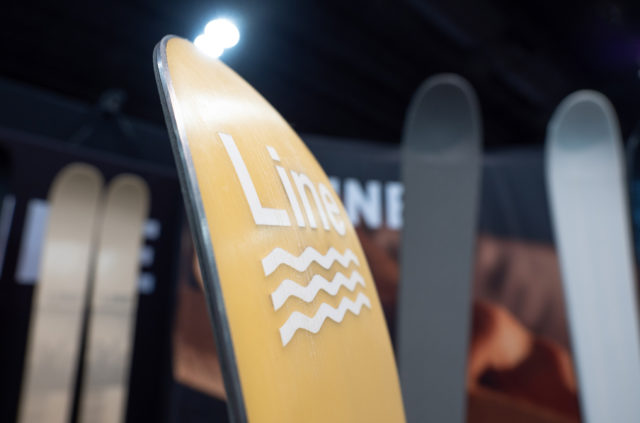
First off, I can’t imagine how difficult it was for Line to actually manufacture the convex tips and tails of the Sir Francis Bacon and Outline, so I don’t doubt Eric’s comments about that. Because while brands like DPS, Atomic, Armada, and Majesty have all incorporated beveled edges into the tips and / or tails of some of their skis, the 19/20 Sir Francis Bacon and Outline are the first skis we’ve seen or heard of that feature truly convex tips and tails, rather than simply having some sort of convexity near the edges.
In the past, we haven’t noticed a huge difference when it comes to skis with beveled edges (e.g., DPS Spoon, Atomic Bent Chetler 120, and Armada ARV 116 JJ). But the convexity on the Sir Francis Bacon and Outline is much more pronounced than those skis, so maybe it’ll make more of a difference? We’ll see.
Shape / Rocker Profile
While the Sir Francis Bacon’s convex tips and tails are very different from the current version of the ski, the new ski’s shape and rocker profile are actually pretty similar to the current iteration.
The 19/20 Sir Francis Bacon’s shape looks a lot like the 18/19 ski, with the 19/20 ski having pretty fat, nearly symmetrical tips and tails and a bit of early taper. The Sir Francis Bacon’s taper lines aren’t deep, but they do come to a fairly sharp point. Apart from the new SFB having a wider 107 mm waist and convex tips and tails, it looks nearly identical to the current version in terms of shape.
The new Sir Francis Bacon’s longitudinal rocker profile is also very similar to the current version’s. The 19/20 Sir Francis Bacon has nearly symmetrical tip and tail rocker lines that are pretty deep for a ski this wide. But like many recent Line skis we’ve reviewed, the Sir Francis Bacon’s tips and tails don’t rise very abruptly, and instead only splay out near the ends of the ski.
Mount Point
No change here. The new Sir Francis Bacon’s recommended mount point is -1.9 cm from center. That’s the same exact mount point as the current version of the ski. So it looks like the new ski is still very much designed for the freestyle-oriented skier who will appreciate a balanced feel in the air and skis with a centered, balanced stance.
Flex Pattern
Here’s how we’d characterize the flex pattern of the Sir Francis Bacon:
Tips: 6-6.5
Shovels: 6.5-7
In Front of Toe Piece: 7-9
Underfoot: 9
Behind the Heel Piece: 9-8
Tails: 7.5-6
Unlike the ski’s shape, rocker profile, and mount point, the new Sir Francis Bacon’s flex pattern is a pretty significant departure from the current ski. The current (15/16-18/19) Sir Francis Bacon is actually a pretty stout ski. The new Sir Francis Bacon is not what we’d call a particularly stiff ski.
The new ski’s tips and tails start soft, and then slowly ramp up in stiffness to a pretty strong section around the bindings. This is in contrast to the current Sir Francis Bacon, which has tips and tails that are quite stiff, and its flex pattern is pretty even overall, with the tips and tails only being a bit softer than the middle.
One gripe we had with the current Sir Francis Bacon was that it wasn’t very easy to butter and press due to its stiffer flex pattern. With the new Sir Francis Bacon, we doubt you’ll have a hard time bending it.
Weight
The current Sir Francis Bacon is already a pretty light ski at around 2050 grams per ski for the 184 cm version.
The 19/20 Sir Francis Bacon is even lighter at around 1880 grams per ski for the 184. That’s really light, especially when you consider that the new Sir Francis Bacon is actually wider than the current version. Compared to all of the other current all-mountain-freestyle skis we’ve reviewed, the new Sir Francis Bacon is the lightest one. It’s similar in terms of weight compared to the 186 cm Line Sick Day 104, which is a ski we love for 50/50 use in the backcountry and the resort.
The current Sir Francis Bacon is one of the less stable skis we’ve reviewed in the all-mountain-freestyle category, and we don’t imagine that the new ski will be more stable. But we are very curious to see if the new Sir Francis Bacon’s lower weight (and potentially, its convex tips and tails) help make the new ski significantly more playful than the current ski.
For reference, here are a number of our measured weights (per ski in grams) for some notable skis. And as always, pay close attention to the length differences to keep things more apples-to-apples.
1605 & 1630 Line Vision 108, 183 cm (19/20)
1848 & 1903 Line Sick Day 104, 186 cm (17/18–19/20)
1875 & 1881 Line Sir Francis Bacon, 184 cm (19/20)
1941 & 1994 Faction Candide 3.0, 186 cm (18/19)
1950 & 1977 Blizzard Rustler 10, 188 cm (17/18–18/19)
1980 & 2016 Liberty Origin 106, 187 cm (17/18–18/19)
1980 & 2019 Moment Deathwish, 184 cm (15/16–19/20)
2010 & 2018 J Skis Vacation, 186 cm (18/19)
2032 & 2062 Line Sir Francis Bacon, 184 cm (15/16–18/19)
2042 & 2105 Line Mordecai, 186 cm (16/17–18/19)
2080 & 2089 Sego Big Horn 106, 187 cm (16/17–18/19)
2113 & 2121 Moment Meridian 107, 187 cm (16/17–19/20)
2113 & 2140 Armada ARV 106, 188 cm (18/19–19/20)
2133 & 2134 Faction Prodigy 3.0, 183 cm (18/19–19/20)
2144 & 2153 K2 Marksman, 184 cm (16/17–19/20)
2221 & 2245 ON3P Kartel 108, 186 cm (18/19)
2241 & 2295 4FRNT Devastator, 184 cm (14/15–18/19)
Some Questions / Things We’re Curious about
(1) As with any updated ski, we’re very curious to see how the new Sir Francis Bacon compares to the current version of the ski.
(2) The 19/20 Sir Francis Bacon is extremely light. So as always, we’re eager to see just how well the new, lighter ski handles rough snow and high speeds.
(3) The current Sir Francis Bacon is a very strong ski, but the 19/20 Sir Francis Bacon is significantly softer. So how much more playful with the new ski feel, and will that come at the cost of much stability at speed and on landings?
(4) The Sir Francis Bacon’s convex tips and tails certainly look interesting, but how noticeable will they be on snow?
Bottom Line (For Now)
The Line Sir Francis Bacon has been around in some form for what feels like forever. The new 19/20 Sir Francis Bacon is very different from the current ski in some regards, while being quite similar in others. Blister Members can check out our Flash Review linked below for our initial thoughts on the new ski, but in the meantime, stay tuned for our full review.
Flash Review
Blister Members can now check out our Flash Review of the Sir Francis Bacon for our initial impressions. Become a Blister member now to check out this and all of our Flash Reviews, plus get exclusive deals and discounts on skis, and personalized gear recommendations from us.
FULL REVIEW
I came into this review not sure of what to expect. I don’t tend to spin all that much, and while I like playful skis, I also tend to prefer directional playful skis, and I appreciate stability. The new Sir Francis Bacon didn’t look like it was much of a match for me.
But after spending around fifteen days on the new SFB, I’ve come away absolutely loving it. And I think many other skiers will, too.
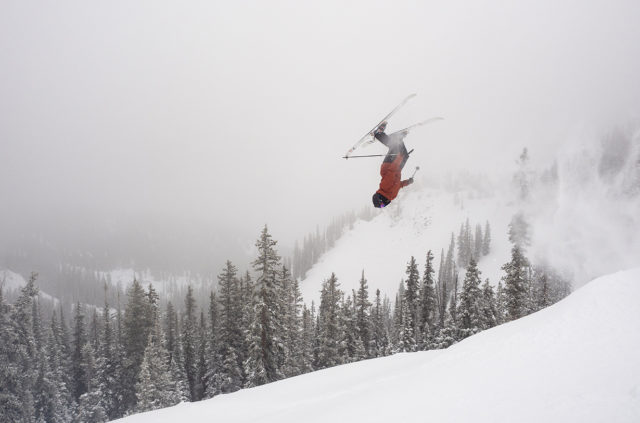
Powder
At around 107 mm underfoot, the new Sir Francis Bacon sits on the wider end of the spectrum, but it’s still designed with all-mountain performance in mind, rather than being designed as a pure powder ski (that’s what the new Line Outline is for).
But in up to about a foot of fresh snow, the Sir Francis Bacon was a blast. Given its moderate width and forward mount point, it floats surprisingly well. It’s still a nearly center-mounted ski, so I had to stay pretty neutral on it and not drive the tips super hard, or else they would dive. But if I did stay centered, the tips planed well and the ski felt super surfy, playful, and loose.
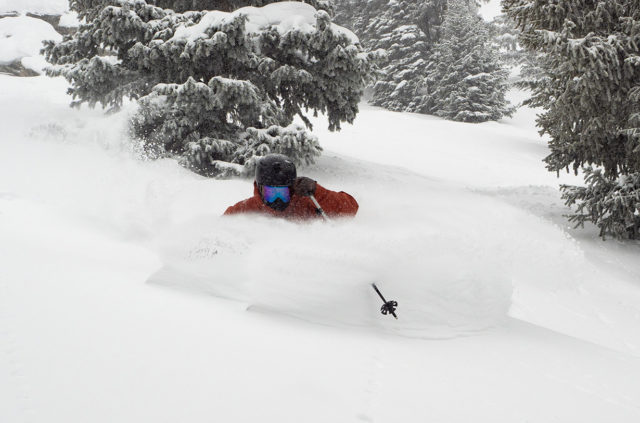
And if you’re wondering if that’s due to the new SFB’s convex tips and tails, I do actually think they play into its surfy feel. There is a distinctive looseness in the new Sir Francis Bacon’s tips and tails, and the ski felt much easier to throw sideways in deep snow compared to most ~107mm-wide skis I’ve been on. That equated to a super playful feel in fresh snow, and had me slashing tight stashes and trying to butter rollers more than I would’ve attempted to on any other ski this narrow.
If you’re a directional skier who likes to really drive / pressure the front of your skis in pow, well, you could probably just stop reading. This is a very playful, freestyle-oriented ski, and it feels best when skied with a neutral, balanced stance. And if the snow is super deep, I’d rather be on the 117mm-wide Line Outline. But for those skiers who already ski with a centered stance and are looking for a mid-fat ski that will let them play around in the occasional (or shallower) powder day, the new Sir Francis Bacon is a ton of fun.
Soft Chop
When only a few people had tracked out the fresh snow, the SFB was still a lot of fun. It’s very far from a charger (it’s soft, very light, and has a lot of rocker), but as long as I stayed balanced, it was easy to ski pretty hard on the Sir Francis Bacon, kill speed in the soft spots with a big slash, and then pop off every patch of cut-up snow.
Later in the day when the snow was very tracked out but still soft, the Sir Francis Bacon felt like it wanted me to dial things back a bit. If I tried to straight-line through denser chop, the ski got knocked around quite easily. But if I got back to the strategy of avoiding (or jumping off of) the set-up patches and carving through the cleaner spots, I could still ski pretty hard on the SFB.
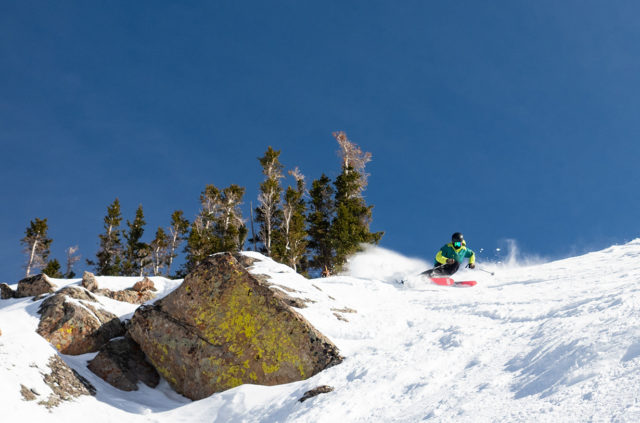
If I had to do the occasional straight-line runout through a field of chop, I found the best strategy was just to lean back a bit and hang on. This is not a ski that you can expect to absorb / mash through every impact — you have to handle that part yourself. But in my opinion, the new Sir Francis Bacon’s playfulness makes up for its instability, which I’ll expand upon later.
Firm Chop & Crud
The Sir Francis Bacon isn’t great when things get really firm and chunky. It’s still predictable, but I had to be pretty deliberate with my turns and line choice while on the Sir Francis Bacon in nasty, firm, choppy snow. If I tried to make big, fast turns on it through crud, well, I started to regret that decision pretty quickly.
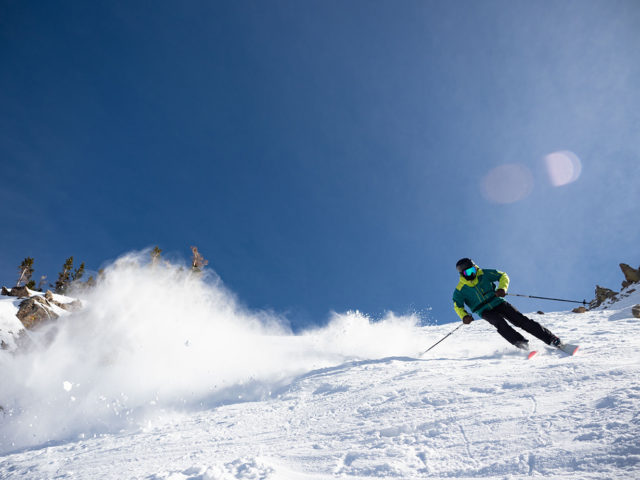
There are plenty of freestyle skis that are better options if you like to mob through crud (see the “All-Mountain Freestyle” section of our Winter Buyer’s Guide). But if you’re willing to trade stability in crappy conditions for playfulness when the snow is good, that’s where the new Sir Francis Bacon makes a lot of sense.
Groomers
If I had to distill the Sir Francis Bacon’s groomer performance into a few words, I’d say that it feels like a freestyle version of the Line Sakana. And that’s a very big compliment.
Like the Sakana, the Sir Francis Bacon is easy to bend into a turn, holds an edge well for its size, and produces a lot of energy coming out of a turn.
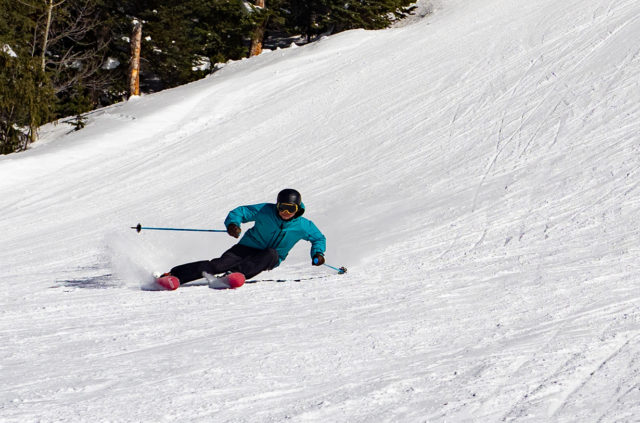
But while the Sakana is a directional ski that rewards a forward, driving stance, the Sir Francis Bacon feels best when skied with a pretty centered, balanced one. I can still press into the front of my boots to really bend the Sir Francis Bacon, but I feel like I’m mostly skiing it from the middle. And since the Sir Francis Bacon has pretty soft tips and tails, it’s still possible to bend the ski into tight turns and get a lot of pop out of the ski, even when you’re not pressuring the front of the ski a bunch.
The Sir Francis Bacon feels like it has a big sweet spot, which led to a fun, unique experience on groomers. I could pressure the front a bit when I really wanted to lay over my turns, I could ski from my ankles when I was taking it easy, and I could even carve it from my heels if I wanted to. I know that’s terrible technique, but, you know what? It’s pretty damn fun.
For a 107mm-wide ski, I think the new Sir Francis Bacon is an excellent carver. Combined with its level of playfulness, that makes the Sir Francis Bacon one of my top picks for when I’m mostly just ripping groomers and popping off any rollers and side hits I can find.
Moguls, Trees, & Tight Terrain
As I alluded to in the Powder section, the Sir Francis Bacon feels very loose and surfy. That’s a big benefit in tight terrain — I can easily wash out the tails or tips of the SFB when I need to.
I still had to stay balanced on the ski when things got steep, as I could overpower the tips or tails if I got too far forward or backward. But if you like to pivot your way through tight terrain with a centered stance, the Sir Francis Bacon is great. It still holds an edge well when you need it too, but is super easy to shut down when that perfect chute ends up being littered with a bunch of trees and rocks.
Mount Point
I’ve spent most of my time on the new Sir Francis Bacon with the bindings on its recommended line of around -2 cm from center. And, to my surprise, I ended up liking it best there.
I tend to prefer skis that I can drive through the shovels when needed, so I tried the SFB with the bindings at -4 cm from center. There, I could drive it a bit more, but I felt like I lost some of the quickness and balanced feel that really define this ski. And since the difference in stability between the two mount points was basically negligible, I decided to just stick with the recommended mount point and take this ski for what it is: a super playful, super fun ski that’s not designed to shoot down the fall line and annihilate everything.
Playfulness & Freestyle Performance
In short, the new Sir Francis Bacon is one of the most playful skis I’ve been on. And that comes down to several aspects of “playfulness.”
First, the Sir Francis Bacon is super easy to slash and throw sideways. It has a trait that Sam Shaheen recently came up with and that I’ve come to love: “sharp / loose.”
The Sir Francis Bacon holds an edge well, carves really well, and yet it’s also incredibly easy to get off edge. That’s true in soft and firm snow. The only skis I’ve used that are looser are all reverse-camber skis, and they often aren’t nearly as fun on very firm snow compared to the Sir Francis Bacon.
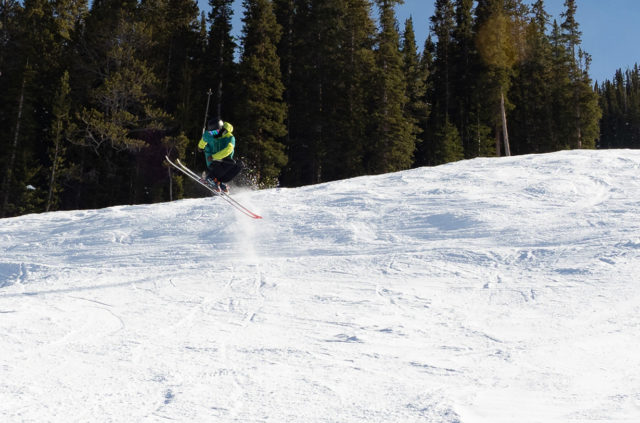
Second, the Sir Francis Bacon is super poppy. It’s very easy to flex into its tips and tails for ollies, nollies, and butters, but unlike some soft skis, the Sir Francis Bacon also has a good amount of rebound when you flex it. So when you bend it, it doesn’t just give out like some wet noodle. Instead, the ski pops back, and I’ve found myself getting more air off of smaller features on the Sir Francis Bacon than pretty much any other ski I’ve been on.
Lastly, the Sir Francis Bacon feels like it’s very much designed to be in the air, and to spin and flip through it.
As I’ve noted in other reviews, I don’t tend to spin or flip that much. But the Sir Francis Bacon had me trying tricks off of new features, and had me doing it more frequently. It feels ridiculously light in the air, and is very forgiving on landings when I under- or over-rotated a spin (i.e., it doesn’t “catch” as easily when landing partially sideways).
The Sir Francis Bacon is not the most supportive ski, so if I landed super far backward or forward, I was left wishing for a ski with a stronger flex pattern. But for smaller airs or when I landed fairly balanced, the Sir Francis Bacon was still supportive enough to keep me from wheeling out or tomahawking over the front.
I’m also not great at butters, but the Sir Francis Bacon made practicing them a lot easier. It’s not very easy to hold a straight-downhill manual or press as the Sir Francis Bacon’s convex tips tend to wash out a bit when you lean really far forward or back on the ski on firm snow. But for quickly getting a butter 3 around, the Sir Francis Bacon’s tips made it a lot easier, and were much less likely to catch unexpectedly compared to most skis I’ve been on.
As I alluded to above, I think the new Sir Francis Bacon’s playfulness makes up for its lack of stability. Some skis are kinda playful and kinda stable, but that leaves them in a middle ground that doesn’t make much sense — why not go with something that’s significantly more stable or more playful? The new Sir Francis Bacon seems like a great option for that latter category.
Who’s It For?
Skiers who are looking for a wider all-mountain ski and prioritize playfulness.
Don’t buy the Sir Francis Bacon if you’re a skier who likes to hammer the front of your skis, wants something that will let you blast through chop and crud, and / or want a super strong tail for big drops.
Do buy the Sir Francis Bacon if you like to spin, flip, or just appreciate a really poppy, loose ski that makes the more moderate speeds at which it excels way more fun.
The Sir Francis Bacon carves really well and floats well for its width, and its super low swing weight, poppy & forgiving flex pattern, and loose feel make it a pretty versatile all-mountain freestyle ski. It doesn’t excel when things are really firm and bumpy, but if the snow is soft and / or consistent, the Sir Francis Bacon is a great option for slashing, spinning, and buttering your way around the mountain.
Bottom Line
The 15/16–18/19 Sir Francis Bacon fell into a bit of an odd place. It was not very stable, yet it wasn’t all that playful compared to other all-mountain freestyle skis. In my opinion, the new Sir Francis Bacon makes a lot more sense. It’s far from the most stable ski, but it’s so playful that I’d highly recommend checking it out if you want to add something to your quiver that makes you want to slash that windlip, spin that drop, and otherwise look at the mountain in a new, refreshing manner. In a word, the new Sir Francis Bacon is just “fun.”
Deep Dive Comparisons
Become a Blister Member or Deep Dive subscriber to check out our Deep Dive of the Sir Francis Bacon to see how it stacks up against the ON3P Kartel 108, Faction Candide 3.0, Sego Big Horn 106, Line Sick Day 104, Moment Meridian 107, J Skis Metal, Armada ARV 106Ti, Nordica Enforcer 104 Free, Faction Prodigy 3.0 & 4.0, and Renoun Citadel 106.

The surface lab has a full 3mm convex base that runs full length from top to tail, now those are some insanely surfy skis at 161-131-161 but still carve a pretty good turn. But you do feel that vee on the base when you roll them on edge. Glad to see other companies going that route on freestyle skis
Hey Blister, I have put about 50 days in on some 184 Devastators, and while I do like them quite a bit, I want a ski that is a bit lighter, with a bit more sidecut and I was thinking a bit wider to replace it.
I was thinking maybe the Mordecai, but looks like those might be discontinued. Based on what I’m describing, do you think the new Bacon could be a candidate, although I wouldn’t really get the added width, but thinking maybe the added tip width would accomplish what I’m after? Or what else might I be missing?
I am looking for an all mountain one ski quiver for tahoe prioritizing playfullness and trees. ( i never hit the park). I am torn between this and the j skis masterblaster. Thoughts?
Thanks!
Given its low weight, it looks like this ski could be a pretty cool option mounted with Shifts. I was also considering the Bent Chetler 120 for this 50/50 role, but I don’t realistically see quite enough powder to use that ski to its full potential. Do you think that the convex tips and tails of the new SFB will pose a significant issue as far as interface with climbing skins is concerned?
You should be fine. I’ve got a set of the Line Outlines mounted with Shifts and use the G3 Alpinist+ Universal skins. There was no issue with either the convex tips or tails and the clip compatibility whilst touring in Japan. The only thing I’d say is to (at least with the G3 tail clip) make sure the tail clip is centered – the shape of the tail is far from flat and if the clip is off centre it won’t stay on.
Sooo basicly what your saying is if you ski Tahoe or live in the PNW, forget the new Bacon because it will fold or not be skiable in 75% of the conditions we deal with, way to go Line
I’m definitely buying these skis and center mounting them. Currently on 177 Nordica Soul Riders center mount and 186 Line Mordecai EP recommended mount -2. I’m 5’7″ and 160 lbs. What length would you recommend? These will be my all mountain crusiers. Mordecai will be my Pow sticks. Soul Riders are my park skis. Based on you length measure I’m thinking the 184s.
How do these do in the park? Should of added that to the review
Any word on how the 190cm 19/20 SFBs will differ from the 184s? I remember your review from last year saying the 190s were considerably stiffer, do you know if that’s the case this year as well?
Thanks!
We haven’t had a chance to hand-flex the new 190’s, but I doubt they’d be disproportionately stiffer. The previous SFB was actually quite stiff in both the 184 and 190 cm lengths, and while the 190 was stiffer, it didn’t feel like they made the 190 some wildly different ski. Rather, it felt like a sensibly stiffer ski, given that larger, more aggressive people would be skiing it. The new 184 cm SFB is significantly softer at the tips and tails compared to the old 184 cm SFB, so I expect that the new 190 cm SFB will be notably softer than the old 190 cm SFB.
I’m 6′-0″ and 215 pounds. I currently ride “The Caddy” by Head. I generally do All-Mountain groomers but also enjoy glades, skiing backwards, and general playing around on the mountain. I need a new pair of skis, and was looking at Line’s Sir Francis Bacon. Wasn’t sure if it was too much of a freeride ski for what I want to do? I still want to be able to tackle a groomed black diamond as fast as I can ski it. Any guidance on a good ski pick? Thank you!
I need your help.
I want to replace my 2012 Coreupt Slasher. It totally loved that ski, i did prefer it over everything i ever had.
Do you have any advice what ski would be the most similar to the Coreupt?
Line Sir Francis Bacon? Line Outline? Or something else?
Thanks in advance!
I had those as well and they were a great all mountain powder ski. Hopefully you get an answer as I’m curious too. I’m looking at the k2 reckoned 112 as well as the bacons.
I’ve finally worn out my 190cm Kastle XX110s. I loved those skis for a daily driver in Colorado. So light and poppy but held a competent edge. They were just so much fun. Do you think these would be a suitable replacement?
I tried replacing them with 190cm Faction Candide 3.0 (112mm model) but they are way more chargerish than I was hoping for. They absolutely rip but they lost a lot of the playfulness I was expecting based on reviews of the older model.
Hmm, that’s a tough one. My main worries with the SFB as a replacement to the XX110 are that the SFB will feel too light and/or soft, and that its radius might feel too tight. Compared to the XX110, the SFB is a lot lighter and has a much tighter radius, so I suspect it’d feel a lot more playful overall. That said, if you like to make big, fast turns — especially though chop — I think it might feel too unstable to you. But if you want to prioritize playfulness, tighter turns, and fun at slower speeds, it could be a good choice.
The other skis that come to mind are the Moment Wildcat 108, Sego Big Horn 106, and Moment Deathwish. All of those skis are much stiffer than the SFB and are more comfortable making longer turns, but they’re still pretty light (I believe they’re notably lighter than the latest CT 3.0). Main worry with them is that they are not particularly soft, and if you found the CT 3.0 too charge-y, I’m a bit worried you’d feel the same about those skis. However, I suspect those skis would feel a bit more playful overall (more forgiving / soft, more maneuverable) than the current CT 3.0. That’s just a guess for now though, since we haven’t been able to try the latest CT 3.0.
How would these compare to the K2 Reckoner 102, 112 and the Völkl Revolt 104? Atm I have a Enforcer 88 for mostly groomers but I want something wider and more playful for the park and for powder, I really want to get into tricks more and do manuals and slashs which is pretty hard on my stiff 88s. I would use them as a touring ski aswell, I only do like 2-3 tours a year with maybe 500-800m height and I would mount a Shift onto them, what do you think about that ?
Great review btw, very detailed but still in structure.